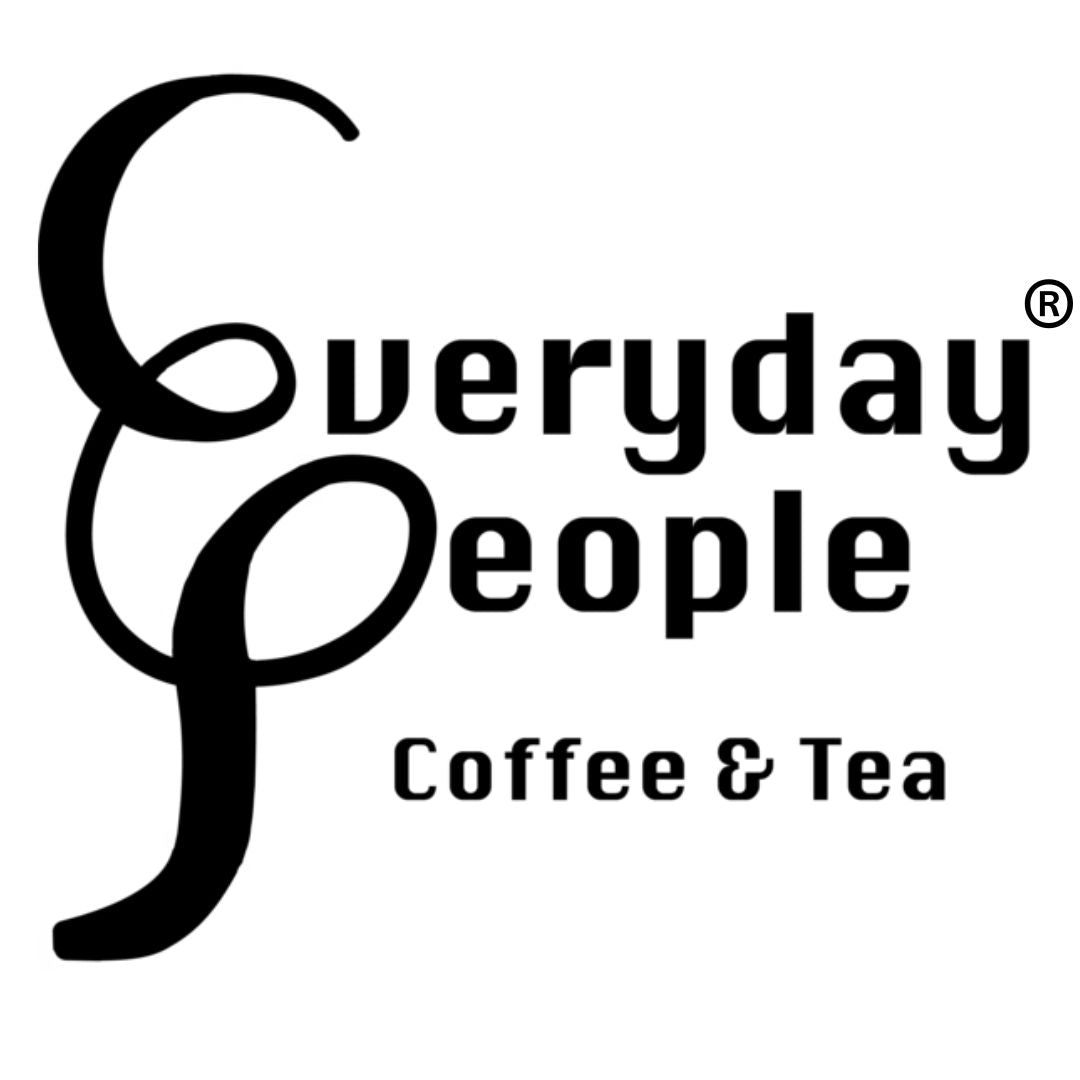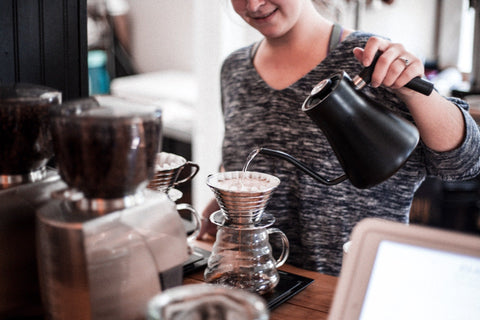If you just have 5 minutes, you can brew a great-tasting cup of coffee with a French Press. A French Press is a carafe with a mesh plunger you press to push coffee to the bottom after steeping. Start with coffee, a French Press, a kettle, and measuring equipment such as a tablespoon or a kitchen scale. The coffee brews by being fully immersed in water for a certain amount of time - just pour, wait, and then enjoy!
How to Use a French Press:
You Need:
A French Press
A way to heat water (ie kettle)
Coffee (whole bean or ground)
A coffee grinder (if using whole bean coffee)
A way to measure your coffee (ie a tablespoon or a scale)
(optional) A thermometer
Steps:
1. Boil the amount of cups of water you need for your coffee (plus a little extra for any water that boils off). While the water is heating up, measure how much coffee you need depending how many cups of coffee you’d like to make. If you enjoy a stronger tasting cup of coffee, you can increase the amount of coffee you brew:
4 cups of coffee or 32 oz: Measure 4 tablespoons (tbsp) of coffee, or 63g if measuring with a scale.
3 cups of coffee or 24 oz: Measure about 3 tbsp of coffee or 47g.
2 cups of coffee or 16 oz: Measure about 1.5 tbsp of coffee or 29g.
1 cup of coffee or 8 oz: Measure about 1 tbsp of coffee or 16g.
Then, grind your coffee coarse and scoop the coffee into the French Press.
2. After the water boils, let it cool for about a minute or until the water temperature is about 204F (95 C). After that minute, pour the hot water on top of the grounds in the French Press. Then, place the mesh plunger on top of the kettle, but don’t press! Set a timer for 4 minutes, and let the coffee brew.
3. After 4 minutes, slowly press the plunger down all the way. Pour all the coffee into your mug or a carafe. Make sure to pour out all the coffee so the coffee doesn’t steep more and become too bitter.
4. Enjoy your French Pressed coffee!
If you like cold coffee instead, you can also make cold brew with your French Press. Simply replace hot water with room temperature water in this recipe, and then steep the grounds for 18-24 hours. When the cold brew is done brewing, it’s good to drink for about 1 week.
Another way of making cold brew coffee sustainably without a French Press is by brewing with the cloth/cheese cloth method. All measurements remain the same.
If the coffee doesn’t come out tasty the first time, don’t worry - there are easy fixes for your next brew!
If the coffee tastes really bitter, you can play around with:
coarsening the grind OR
decreasing how much ground coffee you put in the French Press OR
brewing coffee for a shorter time (less than 4 minutes) OR
waiting for the water to cool down more before pouring it onto the coffee grounds
If the coffee is really sour, you can play around with:
making the grind finer OR
increasing how much ground coffee you put in the French Press OR
brewing the coffee for a longer time (slightly more than 4 minutes) OR
pouring the water on the grounds when it is just off boil OR
stirring the coffee a little while it is brewing
Brewing Sustainably with a French Press
The French Press is already quite a sustainable way to brew coffee, but you can take extra measures to ensure that your entire brew routine is environmentally friendly!
Consider:
What material is your French Press and cup made out of?
How is your coffee grown and sourced?
What are you doing with your coffee grounds or coffee packaging after brewing?
What material is your French Press and cup made out of?
Invest in a glass or metal French press instead of a plastic press. While plastic is a durable and cheap alternative compared to glass or metal, plastic never biodegrades. Furthermore, high temperature water when brewing coffee may leach plastic into the coffee - yielding an unhealthy and plastic-tasting cup of coffee. “Plastic” is a flavor note that we definitely don’t want to find in our coffee.
How is your coffee grown and sourced?
Consumers can make better coffee choices to support a more environmentally friendly industry through choosing a sustainably-sourced, high-quality coffee. These choices can have a major impact on the global ecosystem. Conscious shopping looks like checking for certifications like organic and fair trade. Organic certifications indicate that the coffee was grown without the use of synthetic pesticides that might be harmful to the overall environment, and fair trade certifications tell the consumer that farmers were paid a premium over the market price for their coffees.
There are also other labels that coffee consumers can look for on their bags of coffee or on a coffee company’s information. The customer can check if the coffee is shade grown or bought through direct trade. Shade grown coffee is a more sustainable way of growing coffee than methods that maximize farm productivity. Shade-grown coffee methods promote biodiversity, prevent soil erosion through the shade trees extensive root network, provide nutrients from fallen litter, and decrease the amount of carbon in the air through fixation by plant tissues. Direct trade is an indicator that the coffee company works with the coffee farmers themselves to either set premium prices or even collaborate to support the farmers’ community.
What are you doing with your coffee grounds and packaging after brewing?
Dumping coffee in the landfill means that those coffee grounds will produce methane, a harmful greenhouse gas. You can divert your grounds from the landfill through composting or repurposing your coffee grounds. Composting is an easy, environmentally-friendly action you can do with your used coffee grounds. Simply throw your grounds into your compost pile. When composted, the coffee grounds add nitrogen to the soil. You can also add the grounds right into your garden as fertilizer -- it helps with soil drainage, aeration, and water retention.
After brewing, we can look at repurposing our coffee grounds. Some recipes even call for coffee grounds as rubs or pastry flavoring. You can even use coffee grounds to absorb unwanted odors in your fridge or your trash can. You can also use it as a body scrub to exfoliate dead skin from your body or a way to absorb any residue on your scalp or hair. The journey for coffee doesn’t have to stop in your cup or the landfill.
The coffee lifestyle usually comes along with packaging, so we can be diligent in either recycling or composting any coffee bags or packaging that we come across. Check your coffee bags for the recycling symbol. If it does not have any lamination or plastic in it, you can also use it as brown matter for yours or your community garden’s compost pile.
Understanding the process and mechanism of how coffee has been carefully tended by people all across the world, we at Everyday People Coffee and Tea source sustainable, single origin coffees from farmers, ensuring that those farmers are also provided equitable wages to sustain a livelihood that depends on the coffee trade. We are deeply committed to sourcing quality beans to produce our premium coffees. Our coffee is roasted in a registered and approved FDA facility adhering to sustainable practices.
Let us know how your coffee journey is going at our Instagram @everydaypeople_coffee or our contact form!


